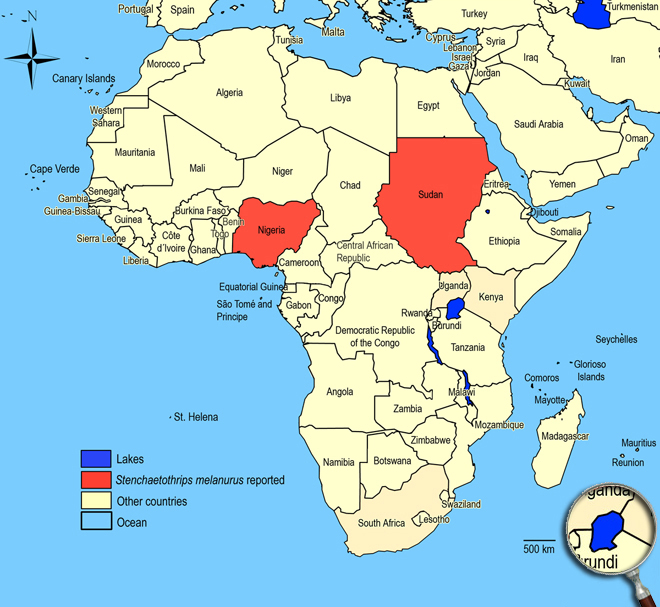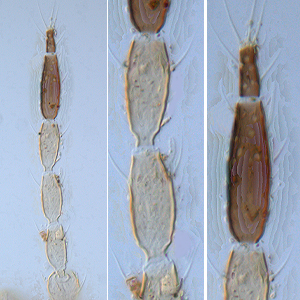Stenchaetothrips melanurus Bagnall, 1926
Thripinae, Thripidae, Terebrantia, Thysanoptera
Figures
Fig. 1: 7-segmented antenna, segments IV and V, terminal segments VI and VII
Fig. 2: Head dorsal with ocellar triangle
Fig. 3: Pronotum
Fig. 4: Meso- and metanotum
Fig. 5: Fore- and hind wing, fore wing distal region
Fig. 6: Tergites IV and V
Fig. 7: Tergites VIII and IX
Fig. 8: Tergites IX-XI
Introduction and recognition
Stenchaetothrips melanurus causes damage on the developing leaves of sorghum. Body color pale yellow, antennal segments VI & VII and abdominal segments 9 & 10 dark brown; fore wings light brown. Antennae 7-segmented; segments III & IV with short forked sense cone (Fig. 1). Head about as long as wide or slightly longer; without sculpture between ocelli; 2 pairs of ocellar setae present, pair I absent, pair III shorter than II and arising anterior to hind ocelli outside the ocellar triangle; postocular setae variable, pair III longer than other postoculars and as long as distance between hind ocelli (Fig. 2). Pronotum with 2 pairs of long posteroangular setae; posterior margin with 2 or 3 pairs of setae; anterior margin with 4 or more setae, 1 pair is elongate and arising behind the anterior margin (Fig. 3). Meso- and metafurca without spinula. Metanotal median area sculptured lines transverse at anterior, longitudinally striate on posterior half; median setae arising well behind anterior margin; campaniform sensilla absent (Fig. 4). Mid and hind tarsi 2-segmented. Fore wing first vein with 2-4 setae on distal half; second vein with complete row of about 12 setae (Fig. 5). Tergites II-VIII with no sculpture medially; median setae small and wide apart (Fig. 6); V-VIII with paired ctenidia laterally, on VIII posteromedial to spiracle; posterior margin of VIII without a comb (Fig. 7 and 8). Sternites without discal setae; posterior margins with irregular, small dentate microtrichia; sternites IV-VI sometimes with small and poorly developed glandular area medially; median setae on sternite VII arising just in front of margin.
Male unknown.
Taxonomic identity
Species
Stenchaetothrips melanurus Bagnall, 1926
Taxonomic history
Baliothrips melanurus Mound, 1968
Common name
-
Present taxonomic position
Family: Thripidae Stephens, 1829
Subfamily: Thripinae (Stephens) Karny, 1921
Genus: Stenchaetothrips Bagnall, 1926
Genus description
The genus Stenchaetothrips Bagnall, 1926
The genus Stenchaetothrips includes 34 species, all associated with grasses and all originally from the Old World tropics (Mound 2011). The genus is closely related to the genus Thrips and has the common character of paired ctenidia laterally on the tergites V-VIII with the pair on tergite VIII arising posterior to the spiracle. In addition, the antennae are 7-segmented, antennal segments III and IV with forked sense cone, absence of ocellar setae I on the head, pronotum with 2 pairs of elongate posteroangular setae, and the metanotal median area is generally longitudinally striate on posterior half. Compared to Thrips, all members of the genus have ocellar setae II much longer than III, mesosternum as well as metasternum without median spinula, and sternites always without discal setae (Mound & Kibby 1998).
Species description
Typical key character states of Stenchaetothrips melanurus
Coloration and body sculpture
Body color: distinctively bicolored or mainly pale to yellow, or with some darker markings
Surface of head, pronotum and fore legs: without obvious or with weakly reticulate sculpture
Antennae
Number of antennal segments: 7
Antennal segment I: without any setae on dorsal apical margin
Antennal segment II: without an exceptionally long seta at the inner apex
Antennal segment II shape: symmetric
Antennal segment III shape: symmetric
Length of antennal segment III and IV: antennal segment III similar in length to segment IV
Form of sense cones on antennal segments III and IV: emergent and forked on segments III and IV
Antennal segment IV and V: without a hyaline ring near the base
Forked sense cone on antennal segment IV: scarcely extending beyond base of segment V
Antennal segment VI bears: not a remarkably dagger-shaped sensorium
Head
Distance between bases of ocellar setae III: greater than width of first ocellus
Head: not prolonged in front of compound eyes
Pair of major postocular seta: longer than other postoculars and as long as distance between hind ocelli
Ocellar setae I: absent
Length of ocellar setae II: longer than setae III
Ocellar setae III: arising on anterior margin of, or in front of ocellar triangle
Ocelli: present
Length of postocular setae: not alternating short and long setae
Number of ocellar setae: 2
Prothorax
Number of pairs of long anteroangular setae: 0
Number of pairs of long posteroangular setae: 2
Number of pairs of elongate pronotal setae: 2
Number of pairs of posteromarginal minor setae: 2-3
Pronotal blotch or internal apodeme: absent
Pronotum shape: broadly rectangular
Pronotum anteromarginal minor setae: 1 pair elongate and arising just behind the anterior margin
Pronotum posteromarginal/posteroangular setae: S2 longer than S3, not equal in length
Mesothorax
Mesosternal furca: without spinula
Metathorax
Metanotal campaniform sensilla: absent
Metanotal median setae: S1 behind anterior margin
Metanotum with dominant sculptured triangle medially: absent
Metasternal furca: without spinula
Sculpture of metanotum median area: transverse at anterior, but longitudinal and parallel on posterior half
Shape of metathoracic furca: transverse, V-shaped
Wings
Fore and hind wings: present, more than half as long as abdomen (macropterous)
Fringe cilia arising: from sockets
Fore wing veins: present
Fore- and hind wing surface: covered with microtrichia
Apex of fore wing: with prominent terminal setae
Fore wing anterior margin (costal vein): with setae and cilia but cilia longer than setae
Fore wing costal fringe cilia: arising at anterior margin of wing
Fore wing first vein: distinct from costal vein
Fore wing first vein setal row: incomplete, with setae not closely and uniformly spaced
Fore wing second vein setal row: complete, setae uniformly spaced
Fore wing shape: mainly parallel sided or margins run continuously towards each other
Fore wing surface: not reticulate
Fringe cilia on posterior margin near apex: distinctly wavy (undulated)
Length of fore wing costal setae at middle of wing: longer than half of median wing width
Shape of fore wing apex: with mainly posterior margin curved to join anterior margin
Fore wings: uniformly light brown
Legs
Fore tibia: not prolonged around fore tarsus
Mid and hind tarsi: with two segments
Color of fore tarsi: pale or yellow, sometimes apical shaded or brown
Abdomen
Pleurotergites: not covered in microtrichia
Sternite II: with marginal setae but no discal setae
Sternites IV, V and VI: with marginal setae but no discal setae
Sternite VII median posteromarginal setae S1: arising in front of posterior margin
Sternite VII: with marginal setae but no discal setae
Surface of lateral thirds of abdominal tergites: without regular rows of fine microtrichia
Number of lateral marginal setae on tergite II: 4
Tergites II to VII median setal pair: no more than 0.3 as long as median length of tergite
Posterior margin of tergites II to VII: without small teeth, but 2 to 3 triangular teeth laterally
Tergites IV and V median setal pair: shorter than distance between their bases
Craspedum on tergites IV to VI: absent
Tergites V to VII: with ctenidia laterally
Craspedum on tergite VIII: without craspedum medially and toothlike microtrichia laterally
Tergite VIII ctenidia: posteromedial to spiracle
Tergite VIII posteromarginal comb of microtrichia: absent
Tergite X: not tubular, longitudinally incomplete
Setae on abdominal tergite X: all setae slender

Similar or related species
Stenchaetothrips melanurus differs from the related species Stenchaetothrips biformis in having a pale yellow body color (only antennal segments VI & VII and abdominal segments 9 & 10 are dark brown), 1 pair of pronotal anteromarginal setae which is elongate and arising behind the anterior margin, tergite VIII without a comb of microtrichia, and posterior margin of tergites II-VII withouth teeth or 2 or 3 triangular teeth laterally. In contrast, Stenchaetothrips biformis has a dark body color, brown antennal segments except segment III and apex of II, all pronotal anteromarginal setae have the equal length and arising at the margin, tergite VIII with a complete comb of long and slender microtrichia, and posterior margin of tergites II-VII with small and laterally directed teeth.
As in the members of the genus Thrips, Microcephalothrips abdominalis, Larothrips dentipes and Fulmekiola serrata, tergites V-VIII of Stenchaetothrips bear a pair of ctenidia laterally, which on tergite VIII lie posteromedial to the spiracle, and all species have no ocellar setae I. In contrast to the species with craspedum on tergites II-VII (Microcephalothrips abdominalis, Larothrips dentipes, Fulmekiola serrata), species of Thrips and Stenchaetothrips have no posteromarginal craspedum on tergites and sternites. Fulmekiola serrata as well as species of Thrips and Stenchaetothrips have 2 pairs of elongate posteroangular setae (Larothrips dentipes without elongate pronotal setae). Compared to the species of Thrips, Microcephalothrips abdominalis and Larothrips dentipes, Fulmekiola serrata and species of Stenchaetothrips have sternites always without discal setae, a mesosternal furca without median spinula, and ocellar setae II much longer than III.
Biology
Life history
As with other thrips species the life cycle from egg to adult is dependent on temperature. The full cycle can take less than one week to over a month and adults may live for more than one month producing several generations in one year depending on seasonal weather (Lewis 1973).
Host plants
Cereal crops: sorghum.
Vector capacity
None identified, but possible mechanical distribution of phytopathogenic fungi and bacteria.
Damage and symptoms
-
Detection and control strategies
-
Additional notes
-

Biogeography
Africa. Nigeria (Mokwa),
Sudan (Khartoum).
African countries where Stenchaetothrips melanurus has been reported

The species Stenchaetothrips melanurus was not observed in surveys undertaken in East Africa on vegetables and associated weeds and crops.
Please click here for survey sites of all observed thrips species of Kenya, Tanzania and Uganda.
Bibliography
Bagnall RS (1926). Brief descriptions of new Thysanoptera - XV. Annals and Magazine of Natural History, Zoology, Botany and Geology. (Serie 9) 18: 98-114
Bhatti JS (1982). Revision of the Indian species of Stenchaetothrips Bagnall (Thysanoptera: Thripidae). Oriental Insects. 16 (4): 385-417
Bhatti JS & Mound LA (1980). The genera of grass- and cereal-feeding Thysanoptera related to the genus Thrips (Thysanoptera: Thripidae). Bulletin of Entomology. 21: 1-22
Lewis T (1973). Thrips: their biology, ecology and economic importance. Academic Press Inc., London Ltd., 349 pp
Mound LA (1968). A review of R. S. Bagnalľs Thysanoptera collections. Bulletin of the British Museum (Natural History), Entomology. Supplement 11: 1-181
Mound LA (2011). Grass-dependent Thysanoptera of the family Thripidae from Australia. Zootaxa 3064: 1-40
Mound LA & Kibby G (1998). Thysanoptera: An identification guide, (2nd edition). CAB International, Wallingford and New York, 70 pp
Palmer JM (1990). Identification of the common thrips of Tropical Africa (Thysanoptera, Insecta). Tropical Pest Management. 36 (1): 27-49
Pitkin BR & Mound LA (1973). A catalogue of West African Thysanoptera. Bulletin de ľInstitut Fondamental ďAfrique Noire, Sèrie A. 35 (2): 407-449
Priesner H (1964). A monograph of the Thysanoptera of the Egyptian deserts. Publications de ľInstitut du Desert d´Egypte (1960). 13: 1-549
----
Web links
Mound´s Thysanoptera pages
Thysanoptera Checklist
ICIPE Thrips survey sites
UNI Halle & Thrips sites
Thrips of California











